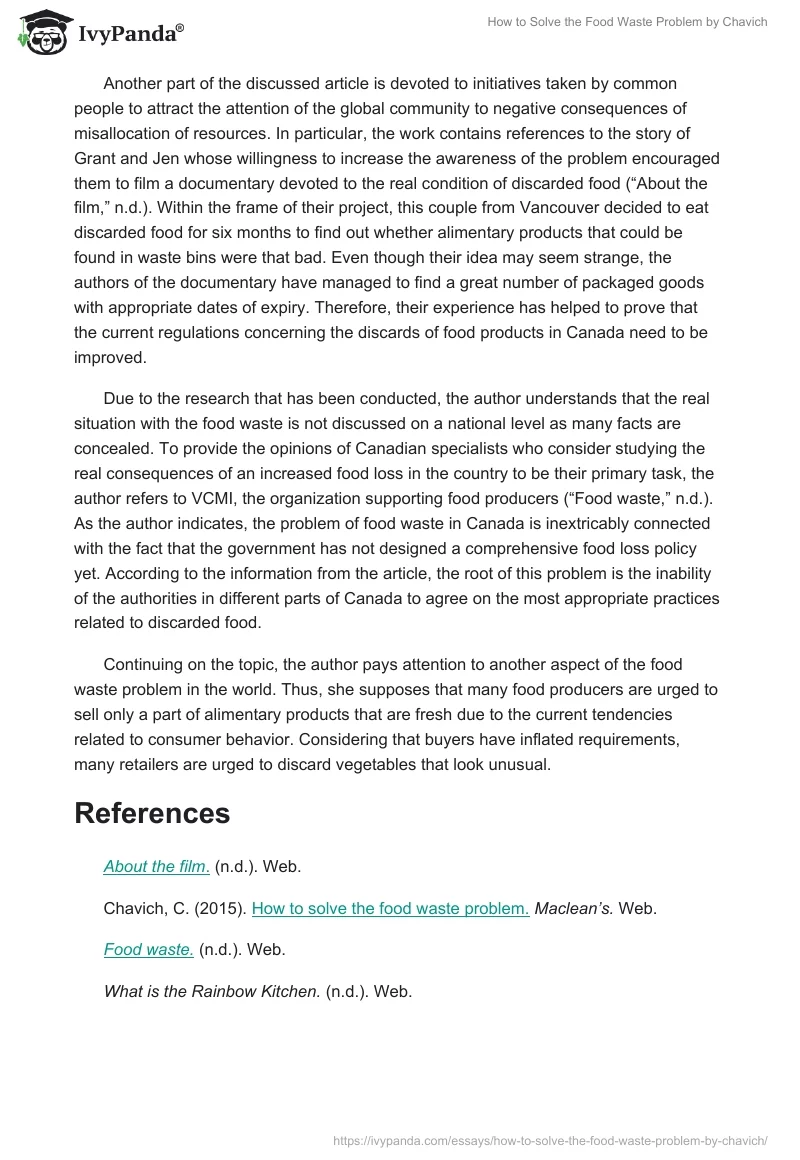The article summarized in the present paper is called “How to solve the food waste problem”, it was written by Cinda Chavich. The discussed work was published in 2015 in Maclean’s online magazine. The author of the article raises an important topic related to the problem of food waste in Canada. In her work, she provides a lot of facts to explain the way that specialists see the best solution helping to reduce the amount of food that is not consumed by people.
The author starts discussing the topic providing the information retrieved during the interview with Daisy Orser, a co-owner of grocery stores in Victoria, Canada. According to this person, the company has already designed and introduced a few systems allowing the management to minimize the number of products thrown in the garbage due to different reasons. Among these ways to optimize working processes, the interviewee lists the use of perishable alimentary products to feed poor people visiting the Rainbow Kitchen and other organizations where they can get a meal (“What is the Rainbow Kitchen,” n.d.). Apart from that, the article claims that perishable foods can go-to containers for biodegradable waste or become a foodstuff for livestock of farmers living nearby. As for other solutions that the company has found to make use of any resources that are bought, grocery stores can send excess berries to special centers where injured and sick wild animals are kept.
The research confirms that “the global issue of food waste” has started to attract more attention of governments recently (Chavich, 2015, para. 3). This tendency, the author believes, can be explained with the help of data that indicates that human society is not able to hide the real situation with food waste any more. Speaking about the problem of alimentary products that are discarded, the author provides the statistical data that may shock many readers; according to the article, about “forty percent of food produced in the developed world” is not consumed by target customers due to a variety of reasons (Chavich, 2015, para. 3). Throughout the discussed article, the author refers to the opinions of numerous professionals who are somehow related to the problem. For instance, she includes the opinions of specialists from NRDC to support her point of view and demonstrate the urgency of the studied problem.
Another part of the discussed article is devoted to initiatives taken by common people to attract the attention of the global community to negative consequences of misallocation of resources. In particular, the work contains references to the story of Grant and Jen whose willingness to increase the awareness of the problem encouraged them to film a documentary devoted to the real condition of discarded food (“About the film,” n.d.). Within the frame of their project, this couple from Vancouver decided to eat discarded food for six months to find out whether alimentary products that could be found in waste bins were that bad. Even though their idea may seem strange, the authors of the documentary have managed to find a great number of packaged goods with appropriate dates of expiry. Therefore, their experience has helped to prove that the current regulations concerning the discards of food products in Canada need to be improved.
Due to the research that has been conducted, the author understands that the real situation with the food waste is not discussed on a national level as many facts are concealed. To provide the opinions of Canadian specialists who consider studying the real consequences of an increased food loss in the country to be their primary task, the author refers to VCMI, the organization supporting food producers (“Food waste,” n.d.). As the author indicates, the problem of food waste in Canada is inextricably connected with the fact that the government has not designed a comprehensive food loss policy yet. According to the information from the article, the root of this problem is the inability of the authorities in different parts of Canada to agree on the most appropriate practices related to discarded food.
Continuing on the topic, the author pays attention to another aspect of the food waste problem in the world. Thus, she supposes that many food producers are urged to sell only a part of alimentary products that are fresh due to the current tendencies related to consumer behavior. Considering that buyers have inflated requirements, many retailers are urged to discard vegetables that look unusual.
References
About the film. (n.d.). Web.
Chavich, C. (2015). How to solve the food waste problem.Maclean’s. Web.
Food waste. (n.d.). Web.
What is the Rainbow Kitchen. (n.d.). Web.


